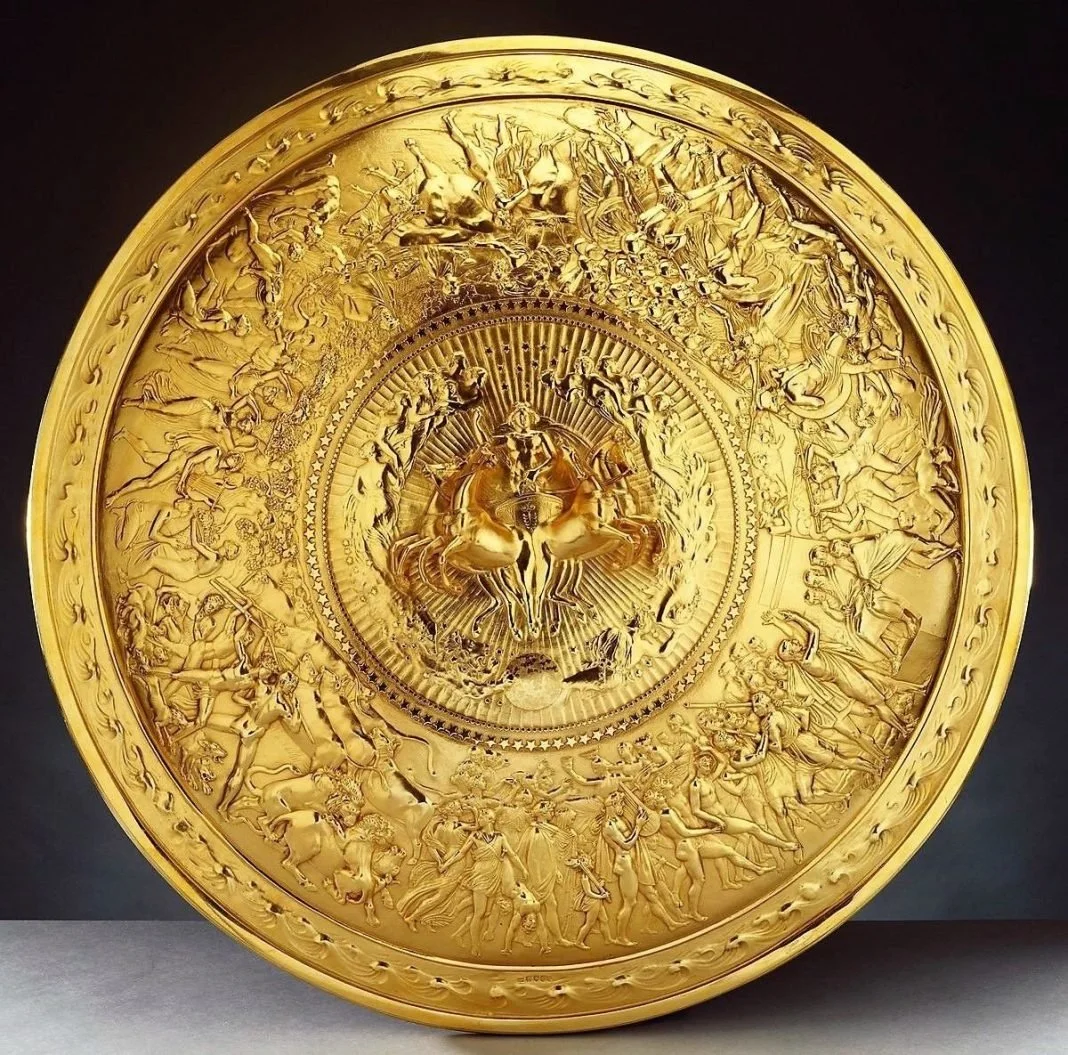The shield of Achilles, immortalized in Homer’s Iliad, stands as one of the most iconic artifacts of ancient Greek mythology and literature. Spanning 134 lines of exquisite description, this artifact is not merely a defensive weapon but a microcosm of the universe, illustrating themes of war, peace, life, and death. Its creation by the god Hephaestus and the intricate scenes it depicts have inspired generations of poets, artists, and scholars. This article delves into the history, craftsmanship, and symbolic significance of Achilles’ legendary shield.
Achilles: The Hero and His Mythos
Achilles, the son of Peleus, King of the Myrmidons, and the Nereid Thetis, is a central figure in Greek mythology. Known for his unparalleled prowess in battle, Achilles was the leader of the Myrmidons, a fearsome force from Phthia (modern-day eastern and northeastern Phthiotis). His story, immortalized in Homer’s Iliad, revolves around his rage (mēnis) during the Trojan War—a wrath so intense it nearly led to the Greeks’ defeat.
According to later myths, Thetis sought to make Achilles invincible by dipping him into the River Styx, holding him by his heel, which remained vulnerable. This tale gave rise to the term “Achilles’ heel,” symbolizing a singular vulnerability amidst great strength.
The Shield’s Creation and Description
Silver-gilt shield modeled after Homer's Iliad by John Flaxman (British, 1755-1826)
The shield of Achilles is introduced at a pivotal moment in the Iliad. After lending his armor to his beloved companion Patroclus, who is subsequently slain by Hector, Achilles finds himself without protection. In his grief and rage, Thetis seeks out Hephaestus, the god of blacksmithing, to forge a new set of armor for her son.
Crafting the Shield
Hephaestus, indebted to Thetis for past kindness, undertakes the creation of a masterpiece. The shield, described in meticulous detail by Homer, is composed of five layers of metal: two of bronze, two of tin, and a central layer of gold. Its surface is adorned with intricate imagery arranged in concentric circles, each depicting elements of the natural world and human society. This description is considered one of the earliest examples of "ekphrasis," a vivid literary depiction of a visual artwork.
The Shield’s Imagery
The Cosmos (Iliad, Book 18: 484-489):
At the center of the shield lies a representation of the earth, sky, and sea. Surrounding these are the sun, the moon, and the constellations, symbolizing the celestial order.
Two Cities (490-508):
One city is depicted in peace, celebrating weddings and legal assemblies. The other is under siege, illustrating the duality of human existence: harmony and conflict.
Agricultural Life (541-560):
Scenes of plowing, reaping, and harvesting emphasize the cyclical nature of labor and sustenance.
Pastoral Imagery (573-589):
A herd of cattle is shown, with lions attacking a bull, highlighting the tension between civilization and the wild.
Festivity and Dance (590-607):
Youths and maidens dance in a circle, a celebration of life’s joys amidst the broader themes of conflict and toil.
Ocean’s Boundary (607-608):
Encircling the entire shield is the River Oceanus, which the ancient Greeks believed encircled the world.
Symbolism of the Shield
The shield encapsulates the entirety of existence as understood by the ancient Greeks. Its layered structure mirrors the interwoven complexities of human life and the natural world. Scholars have proposed several interpretations:
Microcosm of the Universe:
The shield’s imagery integrates opposing forces: peace and war, labor and leisure, life and death. This juxtaposition suggests a holistic view of the world, where opposites coexist.
Moral Commentary:
The peaceful city juxtaposed with the besieged city may reflect the fragility of human order and the ever-present threat of chaos.
Artistic and Literary Legacy:
Homer’s detailed description influenced later works, including The Shield of Heracles, attributed to Hesiod. It also inspired visual representations in classical and modern art.
Academic Perspectives
Wolfgang Schadewaldt, a prominent German scholar, argued that the shield’s intersecting themes illustrate the foundations of a civilized society. The depiction of conflict within the peaceful city reinforces the idea that no state of existence is free from strife. Furthermore, the positioning of the shield’s description between Patroclus’ death and Achilles’ return to battle creates a poignant pause, highlighting the brutality of war and the fleeting nature of peace.
Legacy of the Shield
The shield of Achilles transcends its role in the narrative of the Iliad. It serves as a timeless artifact that encapsulates ancient Greek cosmology, societal values, and the dualities of human existence. Its depiction remains a cornerstone of classical studies, inspiring interpretations that span literature, art, and philosophy.
As a symbol of both protection and reflection, the shield challenges readers to consider the delicate balance between creation and destruction, order and chaos, and the universal truths that govern life and death.
The shield of Achilles is not just an object within the epic; it is a testament to the enduring power of myth and art. Homer’s vivid description invites readers to explore the interplay of themes that define the human condition, making it a subject of fascination and study across millennia. By examining this artifact, we gain insight into the worldview of the ancient Greeks and the timeless questions that continue to resonate in the modern world.










